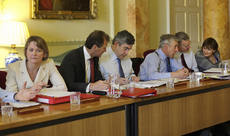 So it seems Yvette Cooper and Alistair Darling are uneasy about Gordon Brown’s Big Lie and told him so in the last Cabinet. The Sunday Times has a story about how they confronted him over the “Labour investment v 10% Tory cuts” strategy last Tuesday – and the Dear Leader was so unchuffed that he finished Cabinet early. As the newspaper says:
So it seems Yvette Cooper and Alistair Darling are uneasy about Gordon Brown’s Big Lie and told him so in the last Cabinet. The Sunday Times has a story about how they confronted him over the “Labour investment v 10% Tory cuts” strategy last Tuesday – and the Dear Leader was so unchuffed that he finished Cabinet early. As the newspaper says:
Unease flared in last week’s cabinet when Brown said of the Tories: “First they will cut by 5%, then by 10%. That is an ideological decision, not a pragmatic one.” But Darling pointed out that Brown’s Tory cuts figures did not represent the party’s policy but were merely “extrapolations” based on figures produced by a think tank, the Institute for Fiscal Studies. Cooper, previously the Treasury minister responsible for public spending, echoed his concerns and warned that ministers must beware of making spending pledges they could not deliver. One cabinet minister at the meeting said: “There is a big difference between us and the Tories on spending, so the cuts versus investment argument is still valid. But we must not allow it to sound that crude. We need to finesse the argument into something more sophisticated.”… According to one source who was present, Brown was visibly irritated at the way he had been undermined, and brought the meeting to an early close, avoiding further debate.
Now, I would dispute Darling’s rather mean-spirited description of figures produced in Coffee House as “merely extrapolations”. Our 10 percent figure was a solid means to quantify verbal Tory promises made at the time, and Brown was quite right to pounce on it. He should have admitted that he’d cut by 7% and include health under his axe – but he’s too dishonest. Had he waited, he could have had a juicier figure. Factor in talk of earlier debt repayment, that Osborne is also talking about, then it”s closer to 15% (according to PWC, which calculates for the NOTW today). But, figures aside, the Sunday Times story reveals a serious issue. To lie, or not to lie? That is the issue dividing the Cabinet.
Brown is utterly relaxed using downright lies, so he will use the “Labour investment v Tory cuts” line as easy as breathing. Andy Burnham is perhaps too innumerate to work out what’s going on, so he’s been repeating it too. Balls has no scruples, so he’s in there claiming spending plans involve a rise after the election. But it seems the rest of the Cabinet do not want to be on record telling outright lies. They can see the figures for themselves, showing spending is going down in real terms – and quite quickly when you factor in debt interest and the dole. Cooper and Darling are not so stupid that they can’t understand this. Byrne has already admitted that there will be cuts, Darling has wobbled too. As far as I know, Mandy has not every repeated the Big Lie – and, as James said on Friday, The Prince is also opposed to it. In fact, we may well compose an ongoing Cabinet list: in one column, those who have repeated the Big Lie (Brown, Balls, Burnham) and those who have only done it with caveats, when pressed, admitted the truth (Darling, Byrne). I do wonder if Cooper will end up on the side of the angels on this one. Stranger things have happened.
P.S. For those who didn’t see it yesterday, the below figures expose Brown’s Big Lie for what it is:

UPDATE: To answer Simon Stephenson, the 7% figure will not be confirmed or denied by the Treasury until it publishes the Spending Review expected next March. But, even using its most dodgy assumptions, it cannot produce a trajectory for a rise in departmental spending. The most cynical move would be to cancel the spending review until after the election and leave Tories to spell out the bad news. What must really frustrate Brown is that the current total spending figures show a tiny downward movement – had his team (Ellam etc) been in HMT you can bet they’d have tweaked the inflation assumptions to produce a rise. Expect just this in the Pre-Budget Report (prob coming in Oct). That is likely to fiddle inflation assumptions downwards to try and magic a real terms increase (however small) in total spending. But after debt interest, it will still be heading down.
On a separate point, I do (unlike Trumpeter) believe HMT will produce a lower total AME estimate because it includes dole costs, tax credit costs etc. They can be quite easily massaged down. But no amount of chicanery can conjure up departmental spending increases. I see no statistical mechanism that Brown can deploy to take his lies and make them true somehow, other than vastly increasing deficit forecasts, which the markets would not allow.







Comments